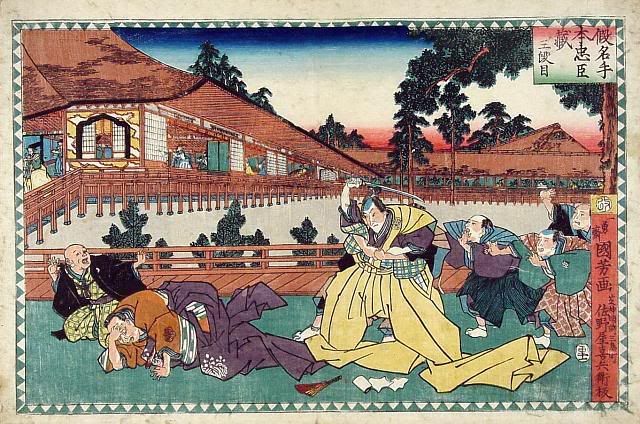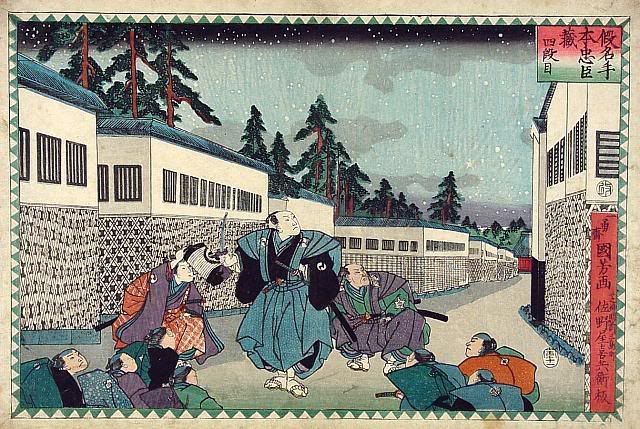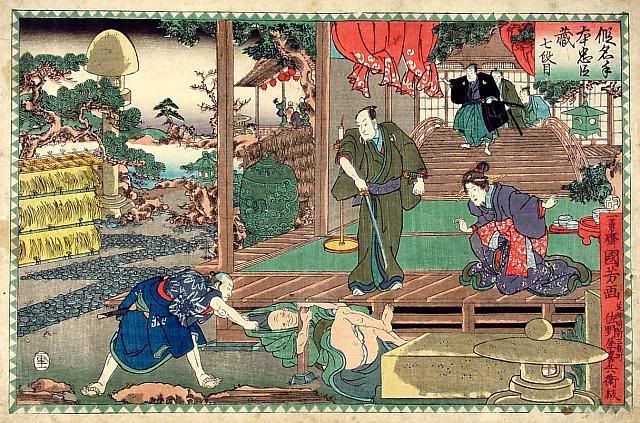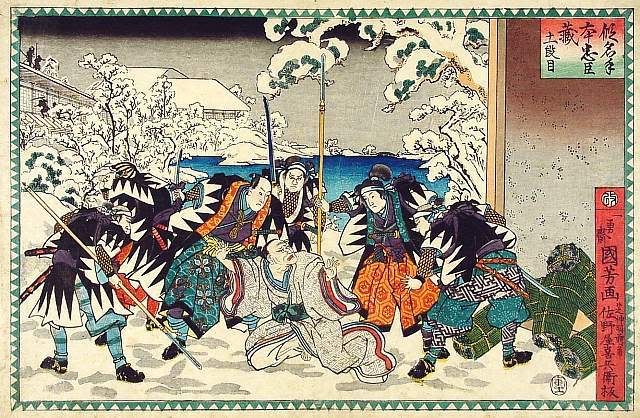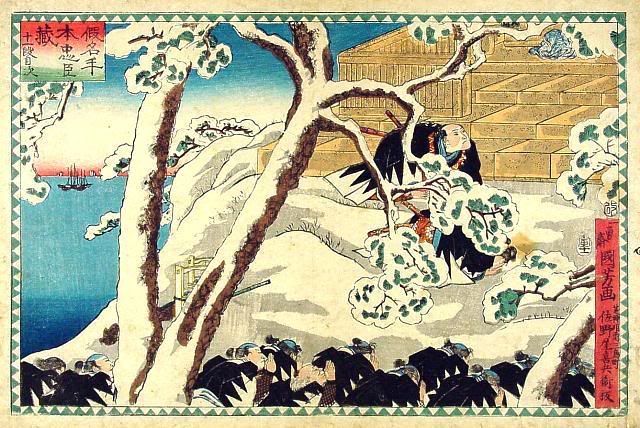LONDON - The Royal Academy of Arts will present an exhibition on one of the greatest Japanese print artists, Utagawa Kuniyoshi (1797 – 1861). Featuring over 150 works, the exhibition will present Kuniyoshi as a master of imaginative design. It will reveal the graphic power and beauty of his prints across an unprecedented range of subjects highlighting his ingenuous use of the triptych format. The majority of the exhibition will be drawn from the outstanding collection of Professor Arthur R. Miller which has recently been donated to the American Friends of the British Museum. This is the first major exhibition in the United Kingdom on Utagawa Kuniyoshi since 1961, on view 21 March through 7 June, 2009. 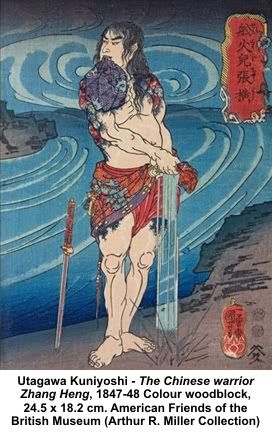
Monday, June 1, 2009
Royal Academy of Arts announces Exhibition by Utagawa Kuniyoshi
Thursday, July 17, 2008
Miyamoto Musashi: famed Japanese swordsman
Kuniyoshi's most famous works focused on folk heroes and placed them within the context of his time. Many of his heroes are placed in his art within the mythological perspective, as the stories were told about them many years after they walked the Earth. In one of the paintings below we will see Musashi killing a Nue, which is a mythological creature. (see prior post about the Nue, http://kuniyoshicat.blogspot.com/2008/02/nue-from-wikipedia-free-encyclopedia.html)
Click the title above to see the entire entry about Musashi, posted at Wikipedia. Here is an excerpt:
Miyamoto Musashi (宮本 武蔵, Miyamoto Musashi?) (c. 1584–June 13 (Japanese calendar: May 19), 1645), also known as Shinmen Takezō, Miyamoto Bennosuke, or by his Buddhist name Niten Dōraku[1], was a Japanese swordsman famed for his duels and distinctive style. Musashi, as he is often simply known, became legendary through his outstanding swordsmanship in numerous duels, even from a very young age. He is the founder of the Hyōhō Niten Ichi-ryū or Niten-ryū style of swordsmanship and the author of The Book of Five Rings (五輪書, Go Rin No Sho?), a book on strategy, tactics, and philosophy that is still studied today.
First duel
I have trained in the way of strategy since my youth, and at the age of thirteen I fought a duel for the first time. My opponent was called Arima Kihei, a sword adept of the Shinto ryu, and I defeated him. At the age of sixteen I defeated a powerful adept by the name of Akiyama, who came from the province of Tajima. At the age of twenty-one I went up to Kyoto and fought duels with several adepts of the sword from famous schools, but I never lost.
—Miyamoto Musashi, Go Rin No Sho
According to the introduction of The Book of Five Rings, Musashi states that his first successful duel was at the age of thirteen, against a samurai named Arima Kihei who fought using the Kashima Shintō-ryū style, founded by Tsukahara Bokuden (b. 1489, d. 1571). The main source of the duel is the Hyoho senshi denki ("Anecdotes about the Deceased Master"). Summarized, its account goes as follows:
In 1596, Musashi was 13, and Arima Kihei, who was traveling to hone his art, posted a public challenge in Hirafuku-mura. Musashi wrote his name on the challenge. A messenger came to Dorin's temple, where Musashi was staying, to inform Musashi that his duel had been accepted by Kihei. Dorin, Musashi's uncle, was shocked by this, and tried to beg off the duel in Musashi's name, based on his nephew's age. Kihei was adamant that the only way his honor could be cleared was if Musashi apologized to him when the duel was scheduled. So when the time set for the duel arrived, Dorin began apologizing for Musashi, who merely charged at Kihei with a six-foot quarterstaff, shouting a challenge to Kihei. Kihei attacked with a wakizashi, but Musashi threw Kihei on the floor, and while Kihei tried to get up, Musashi struck Arima between the eyes and then beat him to death. Arima was said to have been arrogant, overly eager to fight, and not a terribly talented swordsman.
—William Scott Wilson, The Lone Samurai[10]
The duel is odd for a number of reasons, not least of which is why Musashi was permitted to duel Arima, whether the apology was a ruse, and why Arima was there in the first place.
Way of strategy
Throughout the book, Go Rin No Sho, the idea which Musashi pushes is that the "way of the strategist" (Heihō 兵法) is similar to how a carpenter and his tools are mutually inclusive, e.g. - A carpenter can do nothing without his tools, and vice versa. This too, he compares to skill, and tactical ability in the field of battle.
Musashi's metaphor for Strategy is that of the Bulb and the flower, similar to western philosophy of "The chicken or the egg", the "bulb" being the student, the "flower" being the technique. He also notes that most places seem to be mostly concerned with their technique and its beauty. Musashi writes, "In this kind of Way of strategy, both those teaching and those learning the way are concerned with coloring and showing off their technique, trying to hasten the bloom of the flower" (as opposed to the actual harmony between strategy and Skill.)
With those who are concerned with becoming masters of strategy, Musashi points out that as a carpenter becomes better with his tools and is able to craft things with more expert measure, so too can a warrior, or strategist become more skilled in his technique. However, just as a carpenter needs to be able to use his tools according to plans, so too must a strategist be able to adapt his style or technique to the required strategy of the battle he is currently engaged in.
Musashi as an artist
In his later years, Musashi claimed in his Go Rin No Sho that "When I apply the principle of strategy to the ways of different arts and crafts, I no longer have need for a teacher in any domain." He proved this by creating recognized masterpieces of calligraphy and classic ink painting. His paintings are characterized by skilled use of ink washes and an economy of brush stroke. He especially mastered the "broken ink" school of landscapes, applying it to other subjects, such as his "Koboku meikakuzu" ("Kingfisher Perched on a Withered Branch"; part of a triptych whose other two members were "Hotei Walking" and "Sparrow on Bamboo"), his "Hotei Watching a Cockfight", and his "Rozanzu" ("Wild Geese Among Reeds").
Musashi Killing a Nue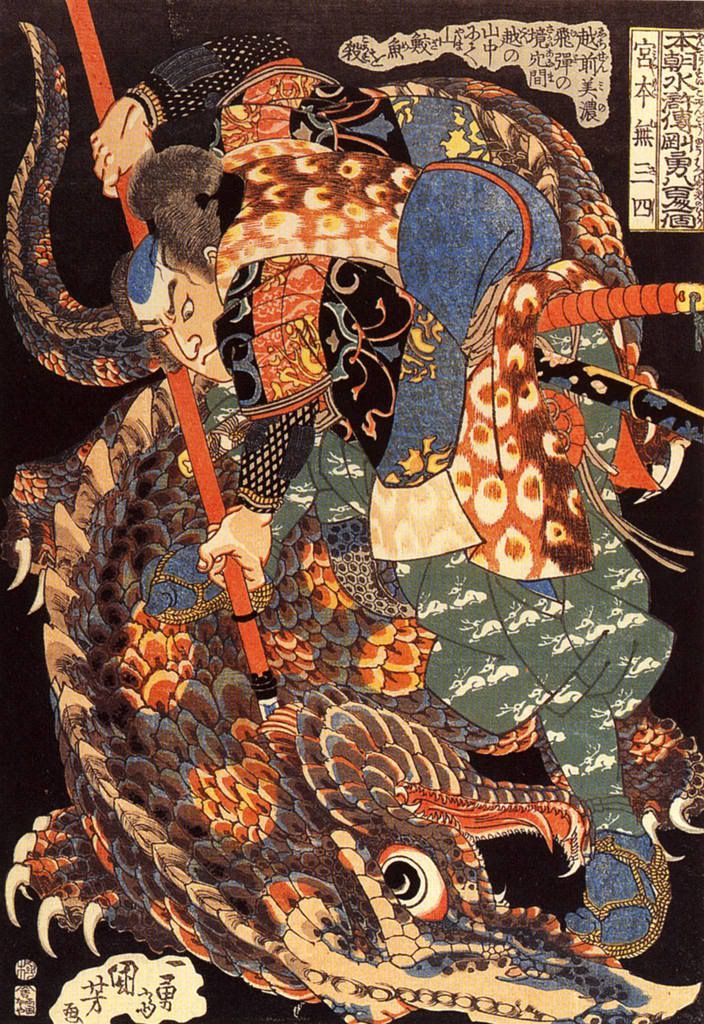
Musashi having his fortune told by a fortune-teller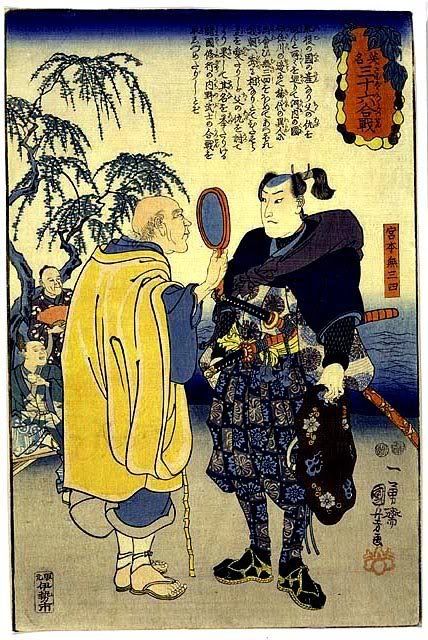
Thursday, June 19, 2008
Very Busy
While I am not disappointing very many people right now (few subscribers) I thought I would make an excuse for not having posted in a month.
I have been very busy.
Enjoy a print for now and I'll add more content soon!
Roshi Ensei Lifting a Heavy Beam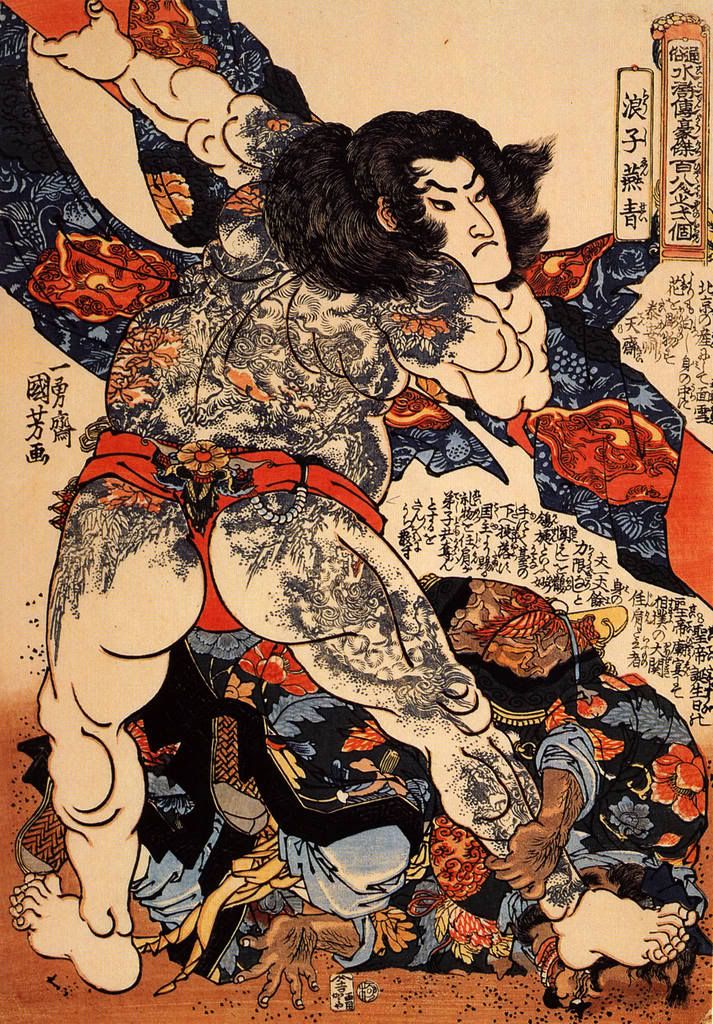
Monday, May 12, 2008
Kuniyoshi T-Shirts
A few shirts, cups, and prints are available through CafePress with many options to choose from. Just click the picture to go to the shop...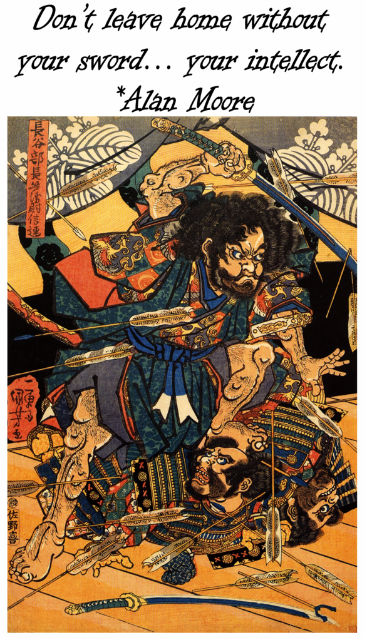
More to come...
Monday, April 28, 2008
Emperor Sutoku and Tengu
歌川国芳
From "A Hundred Verses from Old Japan"
(The Hyakunin-isshu)
translated by William N. Porter
[1909]
THE RETIRED EMPEROR SUTOKU
SUTOKU IN
Se wo hayami
Iwa ni sekaruru
Taki-gawa no
Warete mo sue ni
Awan to zo omou.
THE rock divides the stream in two,
And both with might and main
Go tumbling down the waterfall;
But well I know the twain
Will soon unite again.
Alt. Translation:
Though a swift stream is
Divided by a boulder
In its headlong flow,
Though divided, on it rushes,
And at last unites again.
The town of Kamakura, where is the great bronze image of Buddha Amida, was built by this Emperor, who reigned A.D. 1124-1141; he was then forced by his father, the ex-Emperor Toba, to abdicate in favour of his brother, the Emperor Konoye; afterwards he entered the church, and died in the year 1164, an exile in the Province of Sanuki. This verse is intended to suggest the parting of two lovers, who will eventually meet again.
Legend - from http://en.wikipedia.org/wiki/Emperor_Sutoku
After Sotoku's abdication and exile, he devoted himself to monastic life. He copied numerous scriptures and offered them to the court. Fearing that the scriptures were cursed, the court refused to accept them. Snubbed, Sotoku was said to have resented the court and, upon his death, became an Onryō (Japanese ghost who is able to return to the physical world in order to seek vengeance). Everything from the subsequent fall in fortune of the Imperial court, the rise of the samurai powers, draughts and internal unrests were blamed on his haunting.
Alternatively, he was said to have transformed into an Ootengu, one of the greater tengu (***see definition below), whom, along with the nine-tailed kitsune of Tamamo-no-Mae and the oni Shuten Dōji, are often called the three greatest yōkai (creatures in Japanese folklore ranging from the evil to the mischievous and possess part animal and part human features) of Japan.
Kuniyoshi Print
This selection is from one hundred prints illustrating the Japanese poetry anthology called the Hyakunin Isshu, which was compiled by the poet Fujiwara no Teika 1162-1241 . The Hyakunin Isshu has always been a popular subject, and part of the Japanese culture; it has even taken the form of a card game. This print illustrates the wrath of Emperor Sutoku causing a thunderstorm in Sanuki.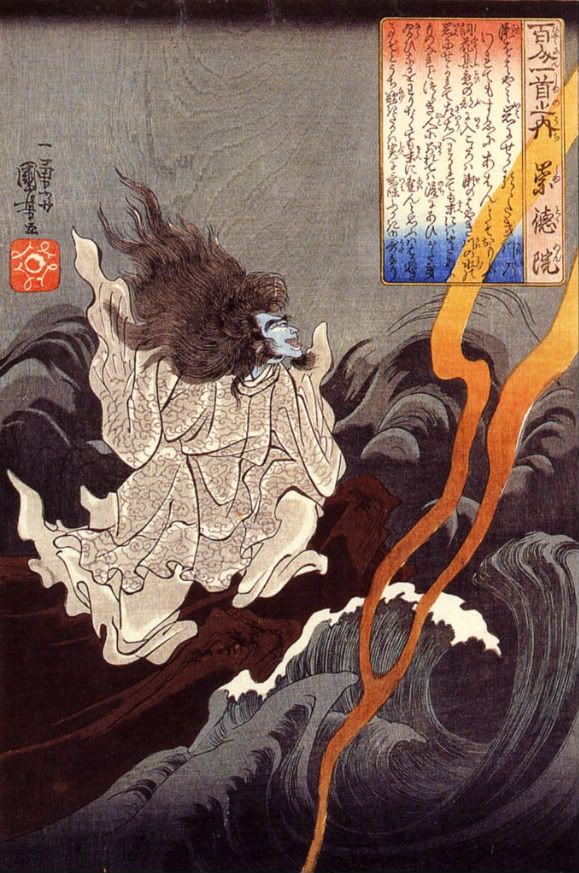
***Tengu - http://en.wikipedia.org/wiki/Tengu
Tengu (天狗, Tengu? "heavenly dogs") are a class of supernatural creatures found in Japanese folklore, art, theater, and literature. They are one of the best known yōkai (monster-spirits) and are sometimes worshipped as Shinto kami (revered spirits or gods). Although they take their name from a dog-like Chinese demon (Tiangou), the tengu were originally thought to take the forms of birds of prey, and they are traditionally depicted with both human and avian characteristics. The earliest tengu were pictured with beaks, but this feature has often been humanized as an unnaturally long nose, which today is practically the tengu's defining characteristic in the popular imagination.
Buddhism long held that the tengu were disruptive demons and harbingers of war. Their image gradually softened, however, into one of protective, if still dangerous, spirits of the mountains and forests. Tengu are associated with the ascetic practice known as Shugendō, and they are usually depicted in the distinctive garb of its followers, the yamabushi.
Elephant catching a flying tengu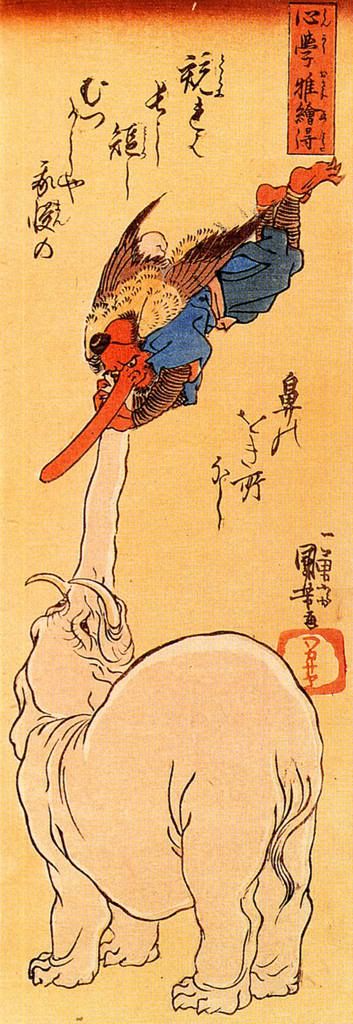
From U. Kuniyoshi's student:
Tsukioka Yoshitoshi, Mount Yoshino Midnight Moon, 1886. From the 100 Phases of the Moon series. 9.25" x 13.5". From here.
Iga no Tsubone confronts the tormented spirit of Sasaki no Kiyotaka, who was forced to comit suicide for giving the emperor bad advice. Sasaki's ghost appears as a troublesome tengu demon, with kite's wings and claws.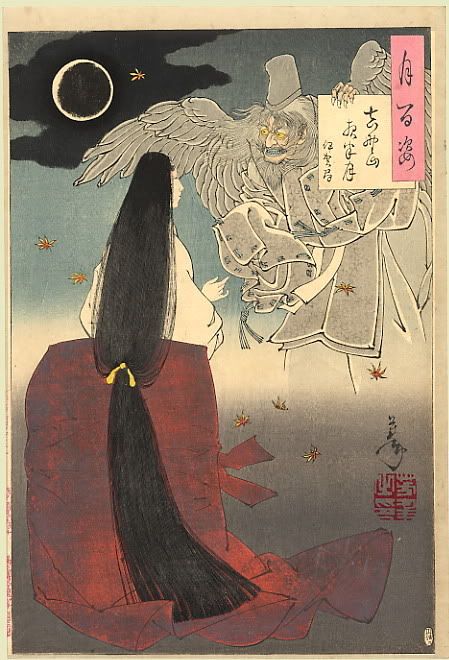
Friday, April 25, 2008
Kuniyoshi: "The Faithful Samurai"
I found this description of the "Chushingura" (the subject of the previous post), which is often referred to as the “Treasury of Loyal Hearts”, and felt it provided a better overview of the story:
Found at http://www.maaa.org/exhi_usa/exhibitions/fully_booked/faithfulsamurai/faithfulsamurai.html
"One of the most famous stories of revenge in Japanese history comprises the exploits of the 47 Ronin (masterless samurai) who avenged the death of their lord in the early 18th century. Their story, the Chushingura, illustrates and defines the Japanese concept of loyalty, providing a supreme example of the samurai ideals of cool courage and fidelity. The Faithful Samurai: Kuniyoshi Woodblock Prints tells this tale through the stunning triptychs, warrior prints, and bust portraits of artist Utagawa Kuniyoshi (1797–1861).
In 1701, a feudal lord, Asano Naganori, was dishonored by Lord Kira, the Shogun's Master of Ceremonies. Lord Asano could no longer bear the insults and humiliating behavior directed toward him by his superior. Despite all efforts at self-control, he drew his sword in a fit of rage and struck Kira, but not fatally. Any violence inside the Shogun's palace was forbidden, and Lord Asano was ordered to commit seppuku, or ritual suicide. His estates and castle were confiscated, and all his men were disbanded to become ronin.
The group of the dishonored Asano's faithful samurai swore an oath to avenge his death. The conspirators had full knowledge that such a plan, if successful, would lead to seppuku for them all, because secret revenge was against the law. After a year of planning, the group came together and attacked Kira's mansion. Following a fierce fight, they beheaded Kira and formally presented the head before the grave of their slain lord. A few months later, all 47 ronin committed judicially imposed seppuku.
This event struck a deep emotional chord in the very heart of Japanese society, and the result was a steady stream of theatrical performances, books, and woodblock prints.
Kuniyoshi was a portrayer of Japanese history and legend. In all, he produced more than 1,600 single-sheet prints and 360 triptychs. But the 47 Ronin especially held his artistic attention with great passion and intensity throughout his 45-year career. He produced 12 series and 20 triptychs devoted to the Chushingura, or “Treasury of Loyal Hearts” as the story is called in Japanese. "
Copyright ©2005 Mid-America Arts Alliance. All rights reserved.
Onodera Junai's wife (one of the 47 ronin) preparing for jigai (female version of seppuku) to follow her husband in death : legs are bound as to maintain a decent posture in agony ; death is given by a tanto cut at the jugular vein. Kuniyoshi woodcut, Seichu gishin den series ("Story of truthful hearts"), 1848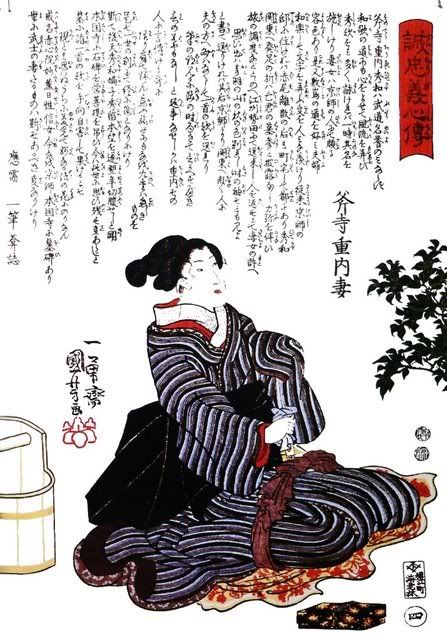
Benkei holding a halberd
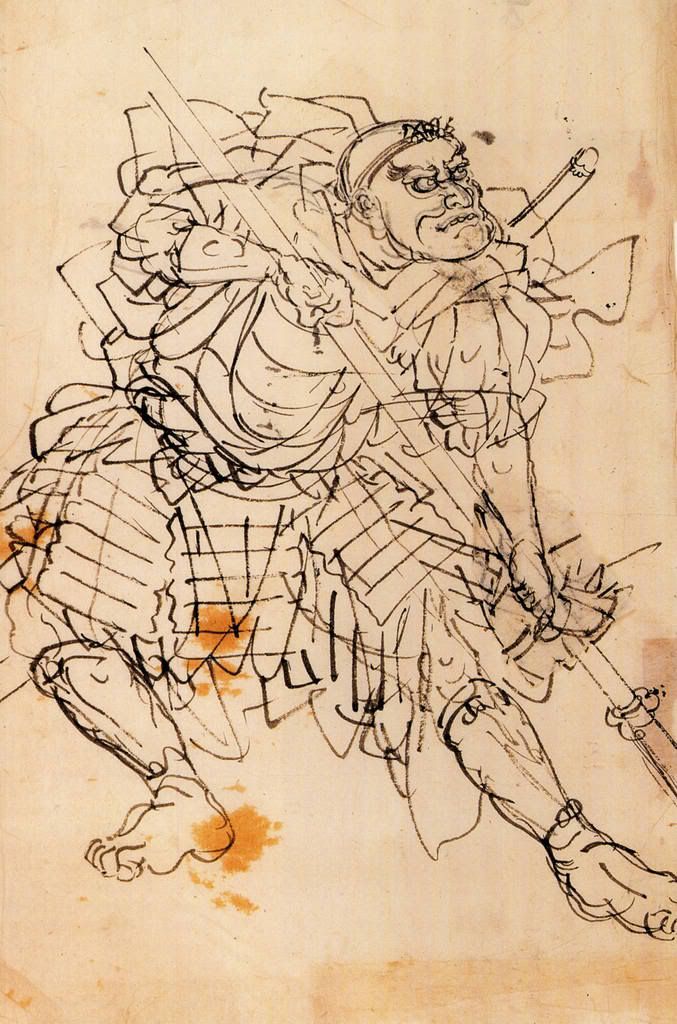
Tuesday, April 22, 2008
Kuniyoshi: Kanadehon Chushingura “a Japanese Kabuki production”
The following is taken from the website for “Degener Japanese Fine Prints”
From: http://www.degener.com/A_1057.htm
Kanadehon Chushingura “a Japanese Kabuki production”
Of the numerous dramas performed in the kabuki theater, by far the most popular as a subject for color prints was the Chushingura, or the "Loyal League of Forty-seven Ronin", mostly published in series of eleven or twelve designs corresponding to the eleven acts of the drama (with occasionally an additional design of one of the extra-scenes of act XI, like in the case of the set by Kuniyoshi represented in this section). The fact that the complete play was illustrated in an entire series of 'tableaux' gives us some idea of its immense popularity, a popularity which it has retained to the present day.
Originally written for the marionette theater by Chikamatsu Monzaemon (1653-1723) and Takeda Izumo (1688-1756),
The revenge-story of his faithful retainers who so had become masterless samurai, or ronin, is the subject of the play, here illustrated by Utagawa Kuniyoshi.
Reference:
Henk Herwig, "Heroes of the kabuki stage",
William Pearl's gradually expanding web site, exclusively devoted to the work of Kuniyoshi: Kuniyoshi Project
Please visit http://www.degener.com/A_1057.htm for all of the prints in this series
Act III:
Yenya's attack on Moronao, he is being restrained, while the latter falls.
Act IV: Hokan's Hara-kiri
Yuranosuke outside the castle by night, holding the dirk with which his lord had performed seppuku.
Act VII: Ichiriku Geisha House
The spy, Kudayu, dragged from under the flooring; Yuranosuke and O-Karu above.
Act VIII: The Bride on her Way
The bridal journey of Konami and her mother, Tonase; they rest under a tree, with
Act IX: The Quiet Retreat in Yamashina
Rikiya attacking Honzo with a spear, Yuranosuke in the doorway.
Act XI / scene 1: The Raid
The ronin in the snow surrounding Moronao, who has been dragged from the charcoal-
Act XI / scene 2: Moronao's head
Yuranosuke and the ronin laying the head of Moronao on their lord's tomb.

